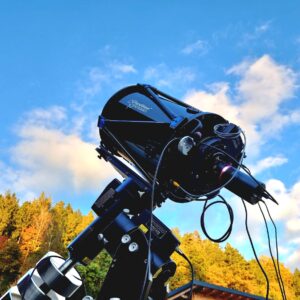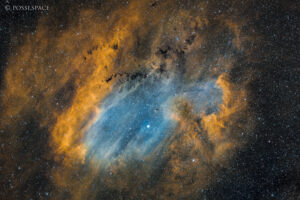Baader Planetarium Blog Posts
-
Change in Standard Body Style of the QHY268C Camera:
This entry was posted on February 8, 2023 Last modified on September 27, 2023.
The "C" model of the QHY 268 has a shorter chip distance to the contact surface as of now. Since January 2023, the QHY268C body configuration will be the same as the QHY268M camera. That is, both the mono and color cameras will have bodies with the short back focal length design. Previously the QHY268C body had the round dovetail ring on the front. However, the short back focal length design is being made standard for both mono and color 268 cameras in response to dealer and user requests to make the QHY268C more compatible with third party filter sliders, electric focusers, etc. This change is entirely mechanical and results in the QHY268C having only 14.5mm of backfocus instead of 24mm with the dovetail ring...
-
First Impression of the new Baader Calcium-Filter
This entry was posted on March 1, 2023 Last modified on February 27, 2024.
In the spring of 2022, I had the chance to give my opinion on a couple of prototypes of a possible successor to the K-Line filter. The calcium line (CaK) was the only part of the solar spectrum that I had not yet covered with my solar setup. This absorption line is indeed somewhat exotic, and the required filters are not very widely distributed. The familiar sight of the white-light (continuum) Sun through a Herschel prism or astrosolar film is probably well-known to everyone who has ever tried solar observation. White light is the cheapest and easiest part of observing the sun - in the simplest case, this can even be done by projection as with the . I have used this part of solar...
-
Observe comet ZTF (C/2022 E3) in binoculars and telescope now!
This entry was posted on January 10, 2023 Last modified on February 28, 2024.
The new year begins with a new comet that may even be visible to the naked eye Comet C/2022 E3 ZTF is coming close to the Sun for the first time in certainly 50,000 years, and on Thursday, January 12, it will come about as close to our central star as the Earth. It has been tracked by amateur and professional astronomers for several months now. It has now about 7th magnitude, so it is observable with common binoculars and even smaller telescopes. However, the currently three-degree-long plasma tail and a short dust tail fan shown in recent photos will not yet be seen visually with small optics. But that will change soon. The well-known comet photographer Michael Jäger sent us an impressive animation and...
-
A quick look at the year ahead in 2023
This entry was posted on January 11, 2023 Last modified on February 28, 2024.
We have just had the Winter solstice (Summer solstice in the southern hemisphere) and, as 2022 draws to a close, we thought it would be interesting to let you know of some astronomy events to look forward to in the upcoming year ahead. Equinoxes and Solstices The Earth’s seasons change on four specific days each year. We have two solstices where the Sun appears to be at its lowest and highest points in the sky (December and June respectively) and two equinoxes where the length of day and night are similar (April and September). As we have just had our winter solstice in the northern hemisphere, we thought we would start off with the equinox and solstice dates for 2023. March 20 - Spring Equinox:...
-
December's Lunar Occultations: Uranus and Mars
This entry was posted on November 29, 2022 Last modified on February 28, 2024.
During the month of December our Moon passes close to the planets Jupiter, Uranus and Mars making such close encountersnic e photographic opportunities. However, the nights of 5th December and the morning on 8th December should be put into your astronomical diary as these dates mark the times when the Moon passes in front of the planets Uranus and Mars respectively. The moon during the course of its orbit around the Earth passes in front of many stars, mostly faint, so when the Moon obsures a planet is quite a rare event. When the Moon passes in front of a celestial object, this event is referred to as a Lunar occultation. The information given below refers to the location of Munich and the times are...
-
DART impact - NASA used large 100mm Baader Bessel filters
This entry was posted on November 24, 2022 Last modified on February 28, 2024.
“The filters worked exceptionally well and we got terrific images post-impact. (See attached photo in Bessel R) We couldn’t have done it without your help, and we are very grateful! Such an exciting and successful mission to be a part of (and lots of observing work).” NASA Hazardous Asteroids research used large 100mm Baader Bessel filters to successfully image DART impact with the MRO 2.4-meter telescope On the 11th of October 2022 after two weeks of analysis, NASA confirmed that the DART mission impact changed the Asteroid's motion in space. NASA's Double Asteroid Redirection Test, or DART for short, used the kinetic impact of a spacecraft to successfully alter an asteroids orbit. The mission involved crashing a spacecraft at 14,000 miles per hour into...
-
First Light: PlaneWave DeltaRho 350 Astrograph
This entry was posted on November 11, 2022 Last modified on February 27, 2024.
I had the chance to test the DeltaRho 350 f/3 Astrograph (DR350) with the serial number 0003 – all in all this solution is absolutely remote capable! You can read my first impressions and experiences here: Setup and installation The unit is very well made and in combination with PlaneWave's focuser and de-rotator, it is quite a massive unit and surprisingly heavy. The center of gravity is at the back of the telescope. The PWI4 (beta) software that operates the DR350 telescope installs quickly and works immediately with Maxim DL. If you have problems, take a look at the USB settings in PWI4, which is used to operate the fans, the heating of the secondary and primary mirrors, the focuser, and the rotator. The DR350...
-
The new "f/2" narrowband filters from Baader in use.
This entry was posted on October 19, 2022 Last modified on September 27, 2023.
A field report after photographic acquisition of five different celestial objects. From Dr. Claus Possberg, Freyung Observatory (www.possi.space) – October 2022 The use of ultra-highspeed systems such as Celestron RASA, Hyperstar, or special astrographs has revolutionized the acquisition of faint nebular objects in recent years, but requires a special filtering technique that I would like to discuss here. An emission line, such as H-alpha at 656.28 nanometers, optimally experiences very little attenuation when passing through a line filter in the central beam. The world's best filters achieve a good 90% transmission here. However, if the beam passes through the periphery of the telescope system, the emission line shifts slightly toward shorter wavelength light (blueshift). If the filters have a very narrow-band transmission characteristic, the wavelength...
-
Baader Planetarium at the International Astronomy Show (IAS) UK
This entry was posted on October 21, 2022 Last modified on February 28, 2024.
After a couple of years break due to COVID, the International Astronomy Show (IAS) was held at the Stoneleigh Park exhibition ground near Coventry/Warwick on Friday 14th and Saturday 15th October 2022. Our UK representative Dr Lee Sproats attended the event to represent us, exhibiting a range of our own and 10Micron products. As is customary, preparations for the event began a few weeks before the show. After travelling the few hours to reach the venue on the Thursday, the setup day, it was time to fill the booth with our display accessories and the 10Micron GM2000 HPS II mount with its hefty but extremely stable Centaurus II tripod. The 10Micron mount head, which "splits" into two parts, is stored and transported along with its...
-
The eyepiece series from Baader Planetarium
This entry was posted on October 17, 2022 Last modified on February 27, 2024.
The eyepiece is half the optics - and every telescope is only as good as its weakest link. That is why Baader Planetarium not only offers high-quality star diagonal mirrors and prisms (which we present in this PDF), but also several series of eyepieces. Each has its own special features, which we would like to present to you briefly here. Besides, they are firmly integrated into the Baader accessories programme and offer interesting solutions for eyepiece projection and binocular observation. The series at a glance Classic Hyperion® Morpheus® Ortho/Plössl Aspheric Modular Zoom Focal length 6 / 10 / 18 / 32 31 / 36 5 / 8 / 10 / 13 / 17 / 21 / 24 8-24 (with Barlow 3,6-10,7) 4,5 /...















